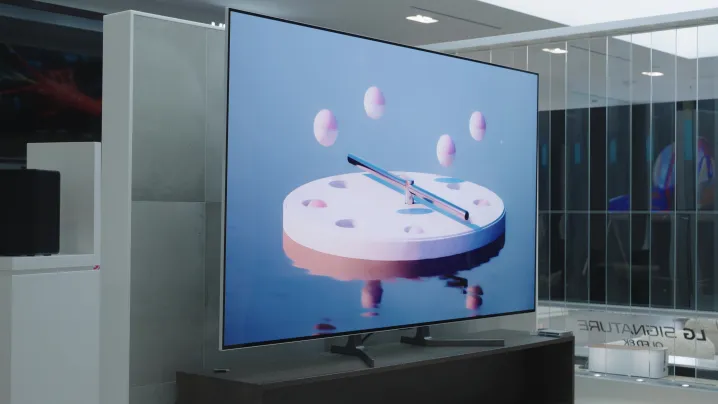You Asked: All in regards to the acronyms, child

On this episode of You Asked, buckle up for an on-the-road version that’s all about acronyms and the troubles people are having with them. ABL on OLEDs, APL, how HDR and WCG will not be one and the identical, MLA panel expertise, and, in fact, eARC.
As you possibly can most likely inform, I’m touring (or I used to be — between the magic of publication dates and my loopy schedule, you possibly can by no means be certain). If you hear honking horns, emergency car sirens, or aggravated pedestrians within the background, kindly do me a favor and fuhgeddaboudit. Hey … when in New York, proper?
Can SDR content material set off ABL on OLED TVs?

David Cobham in Ontario, Canada, is an ice hockey fan who is anxious about ABL, which stands for auto brightness limiter. David is leaning towards an OLED for his new TV, however is confused as as to if ABL applies to SDR content material (that’s customary dynamic vary, or, actually, non-HDR — excessive dynamic vary — content material). Specifically, he means hockey! The very last thing he desires is for all that gleaming white ice to trigger his TV to dim when he’s watching video games — which I collect he does quite a bit.
Thanks on your query, David! First, I’m going to elucidate ABL, after which we’ll get to your particular considerations.
Auto brightness limiter is a characteristic that was created for OLED (natural light-emitting diode) TVs. As simply identified, the O in OLED stands for natural. And as natural beings, we’re very conversant in the organic crucial that’s growing old and demise. The natural compounds that make mild in an OLED TV do put on down over time. And simply as stress accelerates growing old in people, it accelerates the degradation of the natural compounds in an OLED TV. In different phrases: The tougher you drive an OLED TV, the sooner it can put on out.
To delay the lifetime of OLED TVs, an algorithm detects when an OLED TV is being pushed exhausting for lengthy intervals of time, which is a vital qualifier. It then reduces the brightness of the TV mechanically. That’s ABL.
The excellent news is that as OLED TV tech has superior, auto brightness limiting has been relaxed fairly a bit. But if there’s one sort of content material that you would be able to depend on to set off ABL, it’s hockey, which has lots of vibrant white in it. And, sadly, hockey tends to make the auto brightness limiter extra apparent as a result of our eyes are delicate to reductions in white mild brightness.

Over the years, I’ve tried to incorporate an ABL check in my opinions, however it’s less urgent of an issue these days. I suppose I ought to contemplate stress-testing each OLED for ABL, however I simply don’t see it anymore in most forms of content material.
Now, let’s reply David’s query: Yes, SDR content material can set off ABL. In truth, ABL doesn’t care whether or not you’re watching SDR or HDR. It cares about how vibrant the TV is being requested to be. There’s this notion that HDR content material is universally brighter, and that’s not the case. HDR unlocks more dynamic range. And, sure, which means the brightest brights will be brighter. But HDR content material will not be brighter on a regular basis. In truth, some people complain that HDR content material really is extra dim.
So it actually depends upon how vibrant you arrange your OLED to be when it’s taking part in HDR content material. If you max out the OLED mild stage, and you choose choices like “brightness preferred” or HDR peak brightness set to excessive, then your SDR content material could have a excessive common image stage. That’s APL, which is means too shut an acronym to ABL.
With that mentioned, I don’t assume you’ll discover that watching hockey means your TV is continually dimming. The TV goes to get sufficient breaks exhibiting participant’s uniforms, the group, and the commentators, and the ABL is much less more likely to be triggered. If you pause on a really vibrant second within the sport, you’ll see the picture dim slowly over time. But this situation the place the TV slowly dims over time and by no means brightens up? That’s a bug that was present in a only a few TVs, and it was mounted.
So, from an ABL perspective, I believe you’re protected going with OLED. It’s really the potential for burn-in that I’d be fascinated with. If you’ve got hockey on the TV 8 to 10 hours a day, 4 or extra days per week, that rating and knowledge ticker down on the backside of the TV might trigger burn-in. But, hey, in the event you’re apprehensive about that, you possibly can at all times purchase an LG G4. It’s received a five-year guarantee that covers burn-in.
Wide shade gamut and HDR

Jay asks: Wide shade gamut has at all times been promoted as a bonus of HDR video. Very not often, although, have I ever heard it mentioned in TV or video opinions or promoted by TV producers. All the dialogue about HDR appears to middle on brightness and specular highlights, not the improved colours over SDR. So my query is do movie and video makers need to purposely plan for and shoot in a large shade gamut, or do these additional colours simply “magically appear” when watching HDR video? Are we frequently watching HDR video that doesn’t reap the benefits of WCG?
We usually do see HDR and WCG, or extensive shade gamut, talked about in the identical breath. But, the truth is, HDR and extensive shade gamut will not be intrinsically linked. Technically talking, you possibly can have HDR with out extensive shade gamut, and you’ll have extensive shade gamut with out HDR. But the way in which content material is packaged up, we merely don’t see extensive shade gamut content material coming throughout with out HDR.
Wide shade gamut refers to a TV’s talents to provide extra colours than was attainable from the pre-ultra-high-definition days. Broadcast, DVD, and Blu-ray discs had been as soon as capped at sRGB or Rec.709, that are represented by the smaller rectangles on the colour gamut chart.
With Ultra HD, we received extensive shade gamut, which expanded the vary of colours out to this bigger triangle on this shade chart. We name this shade customary DCI-P3, or simply P3 for brief. And since we’re doing acronyms in the present day, I’ll point out that the DCI in DCI-P3 stands for Digital Cinema Initiatives.

So, whereas HDR can impact shade brightness and shade quantity, HDR is about dynamic vary of brightness, and never increasing a shade palette. Wide Color Gamut will increase the vary of shade shades by having the next bit depth — growing from 8-bit shade to 10-bit shade. HDR means a wider vary of colours, and WCG means extra shades of the colours in that vary.
The content material seize — a minimum of for motion pictures — was by no means a limitation. It’s at all times been the supply system. Ten-bit shade requires lots of space for storing or lots of web bandwidth to be delivered. And 4K Blu-rays and trendy streaming companies made it attainable for us to get content material with extensive shade gamut. And it at all times comes with HDR, too.
But the TV wants to have the ability to pull off extensive shade gamut. That’s what makes quantum dots so fascinating. The quantum dots assist develop shade gamut and shade quantity by making a extra pure white mild from which shade filters make colours. OLEDs have naturally higher shade purity and are additionally able to extensive shade gamut.
Anyway, hope that’s useful. And to any shade scientists on the market: Please forgive me for watering down this rationalization. I’m conscious there may be much more to it. But, we’re tying to maintain it on the 101 stage right here.
Any downsides to MLA OLED expertise?

Roy Rosenthal writes: I take pleasure in You Asked quite a bit. My query is about LG MLA expertise. All of the opinions make it sound nice. But is there any draw back to MLA? For instance: Is the off-axis viewing that’s so good with common OLED affected? Or is there any form of content material that MLA doesn’t deal with properly? Or is it only a pure win?
I’ve simply gotten achieved testing the LG G4 OLED, which has LG’s MLA panel. And close to as I can inform, MLA is only a pure win. I don’t see any points inherent to the implementation of the micro lenses that make up MLA. And maybe that’s attributable to how MLA works.
We have an entire explainer on MLA, however the brief model is that MLA stands for micro lens array and refers to a layer in sure premium OLED panels that incorporates billions of tiny lenses — they measure in micrometers — to focus mild out to the viewer. MLA helps OLED TVs be brighter just by funneling mild out to the viewer that in any other case is usually scattered and misplaced. It’s like reclaimed mild output. And it doesn’t seem to get in the way in which of something in any respect.
eARC on HDMI 2.1 ports

Bruce Macartney-Filgate writes in with questions on eARC, which stands for enhanced Audio Return Channel. Bruce’s query is round why he so generally hears reviewers comparable to myself complaining a few TV’s eARC port taking over considered one of a TV’s HDMI 2.1 ports when he thinks that might be a bonus for people utilizing an A/V receiver as a video switcher.
Bruce is correct. For anybody who’s going to make use of an HDMI 2.1-capable A/V receiver as a video switcher — which implies you’ll plug all of the supply units, like sport consoles, Blu-ray gamers, streaming bins, and possibly a cable or satellite tv for pc field into it — it could be a bonus for the TV’s eARC port to even be an HDMI 2.1 port.
Also, for these of you not conversant in eARC or ARC generally: Audio return channel is what permits an HDMI connection to be a two-way road. HDMI cables usually carry sign in a single course, from a supply to a show or sound machine. It will get a sign from level A to level B.
ARC and eARC permit for a video and audio sign to go a method — we’ll name it upstream — and for an audio sign to go the other means, or downstream. This means, people can get sound from their TV — whether or not it’s from built-in apps or from any units linked to the TV — right into a soundbar or receiver. And, lastly, the e in eARC stands for enhanced, and it simply signifies that it might carry extra data, so you may get lossless, uncompressed audio down the pipeline.
Now, a fast reminder for everybody: The solely units that sometimes want an HDMI 2.1 port are the Xbox Series X or S, the PlayStation 5, or a high-end gaming PC. That’s as a result of these are the one units that may provide 4K picture decision at 120Hz, in order that they want the additional bandwidth afforded by HDMI 2.1
So, in the event you had greater than a type of three units and an A/V receiver, then you definitely can be completely happy that the eARC port was additionally HDMI 2.1
But for lots of parents, that eARC port goes for use with a soundbar or maybe an A/V receiver or preamp/processor that doesn’t deal with HDMI 2.1. In these circumstances, in the event you had greater than a type of particular units that want HDMI 2.1, then you definitely would need them to be free in your TV, unbiased of the eARC port, as a result of all of the eARC port must do is get nice audio to your soundbar, or receiver.











